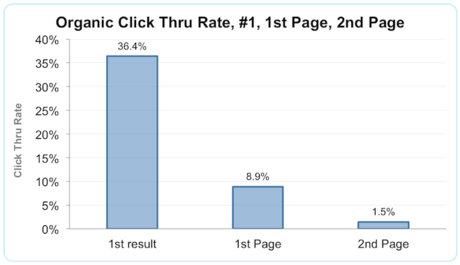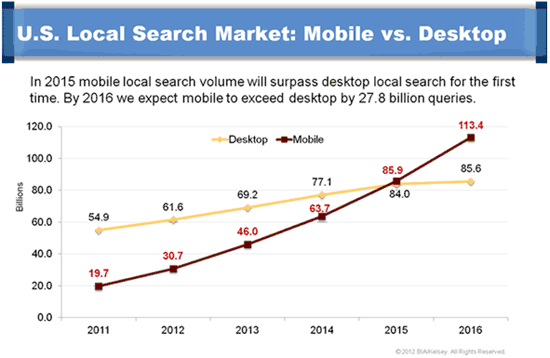“I can’t afford to redesign my website right now,” is a common refrain we hear from clients when extolling the benefits a responsive website (that is, a site which automatically reconfigures its navigation and resizes its pages for optimal browsing on smartphone, tablets, and other mobile devices) will have on their companies. While the upfront cost of creating a new, mobile-friendly website might give pause to some small business owners, the long-term—and by “long-term,” we mean months, not years—revenue increase generated by higher search engine rankings and expanded audience reach will easily justify the initial investment. Customers are searching for your business right now; don’t stand in the way of them finding you.
Still unconvinced? Here are six research-based ways a new responsive website will increase your business’s revenue in the coming year:

#1: Google’s “Mobile-Friendly” Tag Increases Click-Through Rates
“Click-Through Rate” (CTR), or how many people get onto your website (so they can shop, make a reservation, or schedule an appointment) when the site link appears in ads or in search results, is arguably the most important metric in the digital marketing world. A high CTR means customers are intrigued enough by your company’s name, your website’s title, or your page’s description to warrant an investigation (in the form of traffic), while a low click-through rate means that something in your page name, title, or description is preventing potential customers from wanting to learn more about your business.
In an attempt to decrease click-through rates (and traffic) of non-responsive websites, Google has started affixing a small “mobile-friendly” tag to sites that are optimized for mobile devices. These websites, Google reasons, will be more visible in results pages and increase CTRs, especially if a person is searching from a mobile device; from there, the math is simple: more clicks = more traffic = more customers = more revenue.

#2: Mobile Websites Reduce Rank-Decreasing “Bounce Rates”
Another statistic loved by SEOs, “Bounce Rate” measures how long a visitor stays on your pages after they “click-through” to your website. (You’re keeping all these terms straight, right?) Google believes, perhaps not falsely, that if someone finds what they’re looking for on your site (in the form of quality content, easy-to-use layouts, and great services or products), they will stay on your website longer, while pages that DON’T have what users want will “bounce” traffic back to the search results pages. Because unresponsive sites are more difficult to navigate (so much pinching and zooming!) on small screens, websites that don’t cater to the mobile crowd are far more likely to increase your bounce rate.
Metrics like CTRs and bounce rates are creative ways to measure user engagement, sure, but many business owners still don’t understand why they should care about seemingly inconsequential digital marketing stats, especially since these figures don’t directly reflect their website’s sales, conversion rates, or ROI. There’s just one little thing…
#3: Google Uses CTRs, Bounce Rates, and Now Even “Mobile-Friendliness” To Rank Your Website
That’s right; all those “why should I care about this?” metrics actually DO matter, and having a responsive website will give you the kind of numbers—high click-through rates and low bounce rates—that convince Google’s famously-enigmatic algorithm to favorably rank your site (which drives more traffic, generates more customers, increases revenue, etc.). As if to punctuate the growing need for websites to be compatible with smartphones and tablets, Google has even released a new “mobile-friendly” algorithm update. Now, unresponsive sites will be penalized with lower rankings, while sites that look great on all devices will climb through the search engine results pages (SERPs), bringing more exposure and visibility to the website’s business.
The formula is worth repeating: More visibility = more traffic = more customers = more revenue.

#4: Customers Are Becoming Increasingly Mobile (And Revenue-Minded Businesses Must Follow Them)
Just as you wouldn’t rent a storefront in a desolate part of town, hosting an unresponsive website severely limits your exposure to potential customers, clients, or patients. According to Google, mobile web traffic has officially surpassed desktop traffic, meaning that customers are using mobile devices to find businesses, gather information, and make purchasing decisions now more than ever before. Revenue is directly influenced by your website’s traffic, and traffic is increasingly dependent on accessibility; making your site more accessible, logic dictates, will almost certainly increase revenues.

#5: Mobile-Responsive Websites Appeal To Millennials (Who Have Increasingly More Money To Spend)
Millennials (ages 18-35) are known for their impatience and technological adeptness; as America’s most impetuous generation comes into its own, Millennials will also control an ever-growing share of the market. Because most young people use their phones for almost everything—according to a recent study, 90% of Millennials have their smartphones with them at all times, and around 70% prefer using mobile devices over desktop computers—having a responsive website will put your company in a great position to intercept this quickly expanding customer-base.


